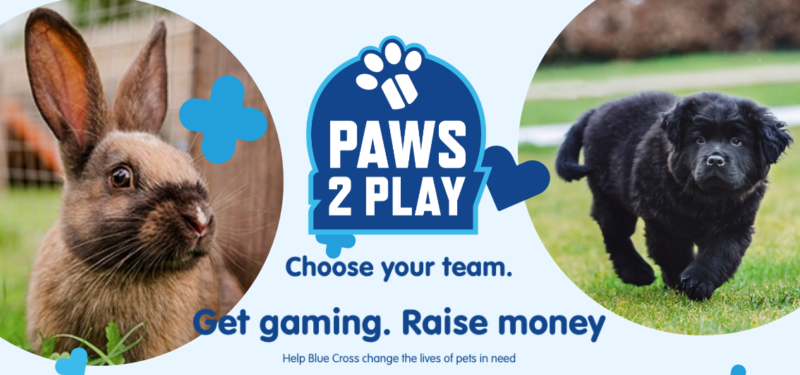Top tips for successful livestreaming & gaming for good
With events like Jingle Jam and GameBlast among others raising significant sums for charities, and the pandemic seeing most of us online more than ever before, livestreaming is an area fundraisers are increasingly considering as a potential income generator for their own organisation.
But where to start and what to think about? Here are some top tips from the experts.
Advertisement
Authenticity is a must
Firstly, look for an activity that suits you, and your audience – it doesn’t have to be gaming, and the beauty of livestreaming is that you can do just about anything. It just needs to be a good fit for your organisation, and your audience.
This is Alyssa Sweetman’s number one tip. The Director of Creator Social Impact at Twitch says:
“It needs to be authentic and engaging. It’s better if charities live stream something that fits with their mission. Putting an employee on playing games doesn’t automatically ensure that an audience will show up or find it engaging.”

Finding the right activity
If you’re trying to work out what you could do in this arena, Lauren Levy, Customer Success Manager at JustGiving, suggests looking at what works for your organisation offline, as well as going out to your key audiences and asking what interests them:
“Use what you know about your audience to build what your activity will look like. Have you seen any trends with fundraising? Is there anything popular you could pivot to a livestream? Your supporters are probably the warmest audience you’ll have, so take some time to talk to them and see what they’d like to see you do. For a low cost way of finding out, throw some polls out on social media and ask.”
Focus on the ask
To encourage support, the ask needs to be front and foremost. People are driven by the thought that they’re making a difference, so knowing where the money is going and the impact it will have is critical for success.
Tom Downie, UK Charity Manager at Tiltify uses last year’s Jingle Jam as a prime example:
“What works for charities is the ask. Jingle Jam had a hardcore gamer audience making donations and receiving games in return, with 12 charities to choose from. Ordering those charities in terms of who raised the most and the least, those that talked about the charity rather than gaming did the best. This is exactly how community fundraising works. What you’re fundraising for should be front and centrepiece. That’s what people can get on board with.”
Building engagement
Building and sustaining engagement is of course vital, and there are some key ways of achieving this with livestreaming and gaming for good.
Influencers can be great for helping you drive engagement and participation – whether it’s a high profile streamer or a celebrity, and if you do want to get an influencer involved, Alyssa Sweetman offers some advice on how to approach them:
“Reach out to them, all influencers have their emails posted somewhere on their social media. Shoot them an email, keep it simple. Don’t ask for a call or if they are interested… give them the information on how to fundraise for you and see what happens. The worst thing a charity can do is send a super long email or just ask for an exploratory chat.”
Spend time too getting to know them in terms of what they’re good at, and what they like, so you can use this to get the best from them in your event, as well as ensure they have a good time.
If you’re looking to build a community and increase your supporter base, the key is providing consistent live content. Jake Ward, Business Development Director at Groovy Gecko, says:
“Think of livestreaming as a regular event rather than a one-off as that’s how they’ll build momentum. Try to time them with your audience in mind. It could be a regular weekly coffee break or Friday evening entertainment. The more consistently you do them, the more word-of-mouth has the opportunity to spread.”
If you’re asking supporters to fundraise for you through gaming or livestreaming, develop the supporter journey to build engagement pre-event where possible too, says Lee Clark, founder of GivePenny:
“Look for ways to extend that supporter journey, and build a community. Encourage a streamer to be sponsored for every hour they do between two dates for example. This then lets you explain the journey to the streamer – how to set up a fundraising page, and ask friends and family to donate to a streaming hour, giving you as a charity the ability to craft a supporter journey that allows you to support them.”
As another example, GivePenny has also worked with Blue Cross on its Paws 2 Play initiative. This saw the charity build a community of streamers on Discord simply by asking people to join it in the sign up process. Clark adds:
“This allows a dialogue with fundraisers, allowing them to communicate with them and give advice, keeping them as close as possible on their fundraising journey.”
During the event itself, offering extras along the way can be an effective way of keeping engagement high both among your fundraisers and their audiences. Running competitions to win a small prize or a donation for their chosen cause, polls where people donate to vote, or setting milestones and incentives such as celebrating every £100 raised in a livestream can help to keep the momentum going.
Marie Curie’s Celebrity Quizzes have raised thousands for the charity. Livestreamed on Tiltify in the run up to Christmas, they included Georgia & David Tennant’s Dr Who Quiz, Mel Giedroyc’s Christmas Party Quiz, and Louis Theroux’s Weird Year in Review. Free to join, the charity encouraged people to donate if they could, at a suggested £5 for taking part, but also incentivised donations throughout the quizzes in other ways.
Tiltify’s Tom Downie explains:
“Marie Curie used their own Twitch channel and got celebrities to do quizzes for them, which included interesting polls: vote for your all time favourite Xmas movie raised £1,000 for example, while asking people to guess who David Tennant’s wife’s favourite Dr Who was raised £17k. They also offered different rewards, such as donate £3 for some Dr Who socks.”
Another key tip is to ensure you do a follow up after the event to encourage continued support.
JustGiving’s Levy says:
“Say how much you’ve raised and highlight why their support is important. Research has shown that people often fundraise once and never again because they don’t know what impact they’ve had.”
Not just for fundraising
And don’t forget, regular livestreaming can also be an invaluable channel simply for keeping supporters updated and engaged. Groovy Gecko’s Ward says:
“It could be as simple as using your mobile to keep people updated on how the charity is doing or what you’re planning. It’s important to remind your supporters that you’re still there. It might only be 100 or so people that you’re talking to at one time, but they could be 100 valuable, regular supporters.
And as charities battle the impact of the pandemic, this avenue can be particularly useful. He adds:
“Be honest. Tell your community what you’re up against, what you need, and how you’re getting by. Online fundraising is here to stay throughout the pandemic and beyond, so it’s important to utilise these live tools as a valuable revenue channel.”
Two charity campaigns, and what made them a success:
War Child UK’s RISING campaign
War Child UK launched RISING to engage grassroot musicians in supporting its Coronavirus Crisis Appeal by getting them to participate in live-streamed fundraising gigs during lockdown, and encourage their fans to donate to the charity. Participants were incentivised with the top 20 fundraisers able to submit a recording to special guest judges for the chance to win a prize. It raised over £80k for the charity.
The charity’s music team explains how they went about it, and what made it a success:
“Alongside London-based promoters, Hot Vox, we launched a new campaign to engage grassroots musicians to support War Child by participating in live-streamed fundraising gigs. Artists encouraged their fans to donate via Tiltify, throughout their performance and via social media before and after. Tiltify worked as a brilliant and interactive platform, as artists and viewers could see in real-time how fans were engaging and what donations were made.
“With Hot Vox’s huge database of solo artists and acoustic acts, we were able to sign-up around 400 artists, all with their own individual fanbases. We also included reward incentives to add to the competition and give something back to participants – these included milestone fundraising target t-shirts, hoodies and gig tickets. However, our main incentive was our music industry judging panel, who listened to the top 20 fundraisers submitted songs and chose a winner for the grand prize.
“The key elements to making the campaign a success were, having a clear programmatic message, perfect timing (middle of lockdown 1.0!), and strong incentives to encourage fundraising.”
CoppaFeel’s Big Bounce Back event
CoppaFeel’s Big Bounce Back saw its founders Kris and Maren complete 12 hours of bouncing on their Bellicon trampolines with the help of some celebrity pals. It gave people the option to sponsor them, or to take on their own bounce challenge, but the event itself also incentivised donations in other ways.
Emmie Kingdon, Events and Marketing Executive, CoppaFeel – Big Bounce Back event, explains what made it a success for the charity:
“For us, we tried to make sure that the content on our livestreams was as engaging as possible for an online event: we tried to refrain from using any pre-recorded content and encouraged our guests to interact with our hosts/talent through features such as live chats and polls. This also worked well for donations as interactive features and incentives such as polls and targets on Tiltify (e.g. if we reach £X, this will happen) really built anticipation and encouraged people to keep watching and donating. The key thing was to try and make people feel as if they were at the event together, even though they were all watching remotely.”







